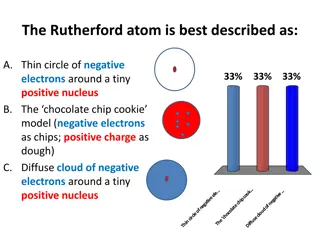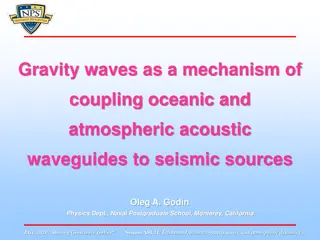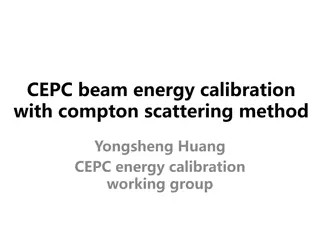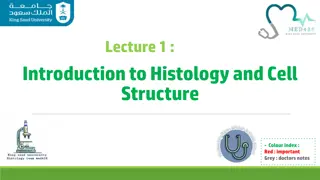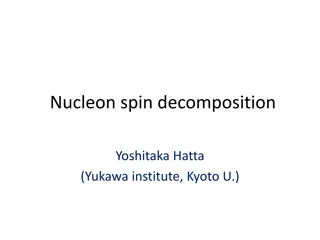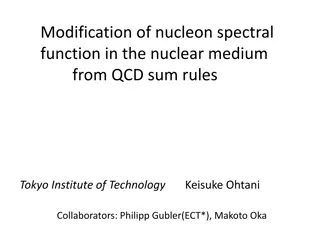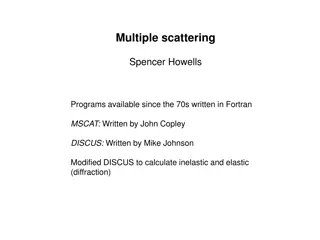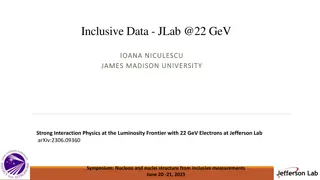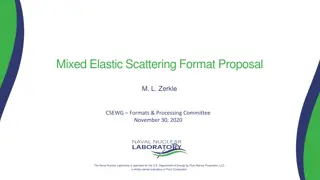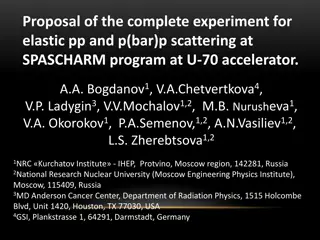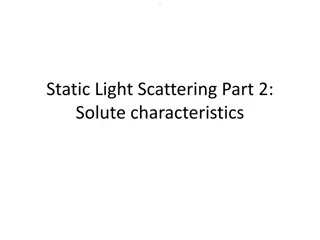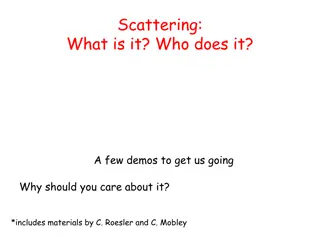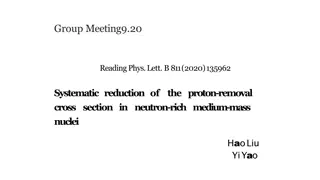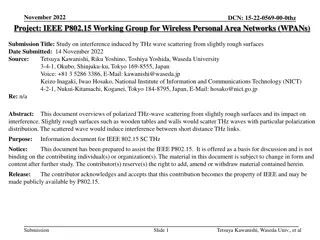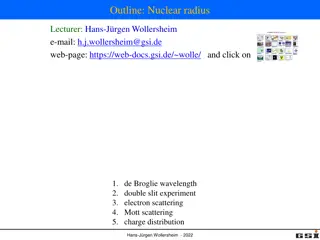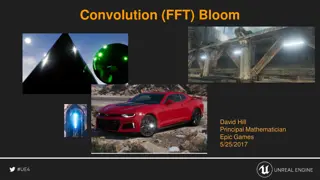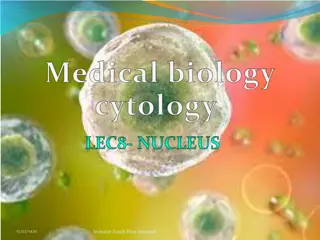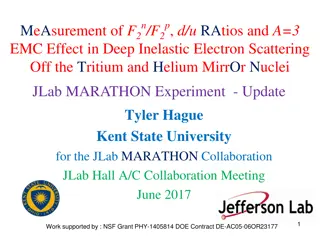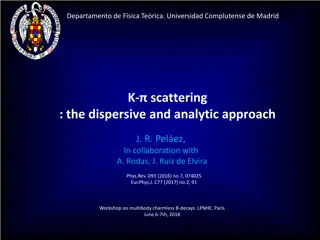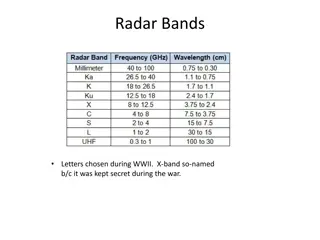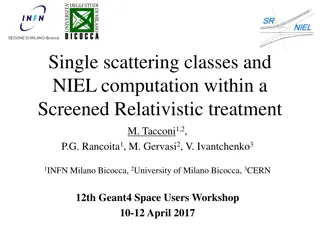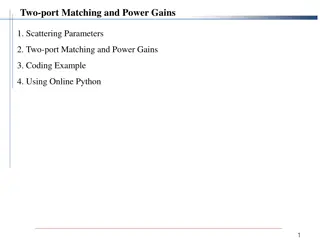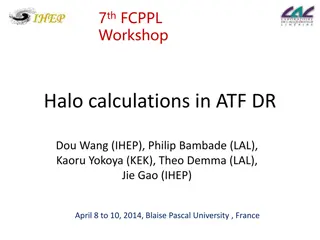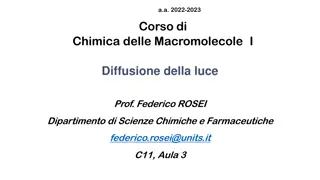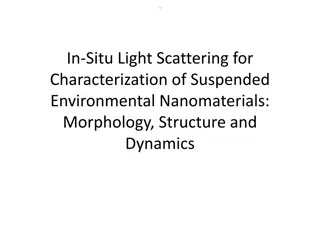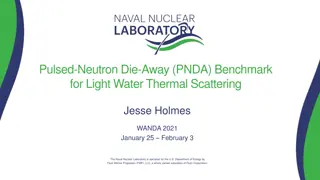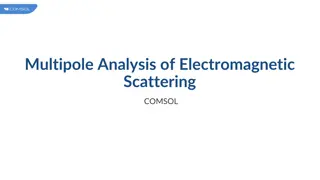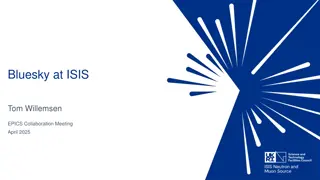Nucleon Structure: Insights from EIC Workshop
Exploring the mechanics of nucleons and the physics goals of the Electron-Ion Collider (EIC), this content delves into the origin of nucleon mass and spin, emergent properties of dense gluon systems, and energy-momentum tensor in QCD. It discusses the role of gluons in understanding nucleon structur
1 views • 31 slides
Diffraction Processes and Meson Production in Nuclear Interactions
Exploration of diffraction dissociation of nuclear nucleons in nucleus-nucleus interactions using Geant4 FTF model and NA61/SHINE results for various nucleus combinations. Insights into meson production in argon-nucleus interactions at different energies and the impact of models like DCM/AGT, UrQMD,
2 views • 17 slides
The Rutherford Atom and Its Structure
The Rutherford atom is characterized by a thin circle of negative electrons surrounding a tiny positive nucleus. In this model, the electrons are in a diffuse cloud around the nucleus, forming the majority of the atomic volume but only a small fraction of the mass. Protons define an element's atomic
0 views • 17 slides
Gravity Waves as a Mechanism of Coupling Oceanic and Atmospheric Acoustic Waveguides to Seismic Sources
Direct excitation of acoustic normal modes in horizontally stratified oceanic waveguides is negligible for shallow earthquakes due to velocity disparities. This study evaluates the contribution of scattering by hydrodynamic waves in generating abyssal T-waves. The research explores the role of scatt
1 views • 6 slides
Beam Energy Calibration with Compton Scattering Method
The CEPC beam energy calibration with Compton scattering method led by Yongsheng Huang and the CEPC energy calibration working group involves collaborations with various institutions and organizations. The project includes detailed physics requirements, system designs, and implementation plans for b
0 views • 14 slides
PN Junction in Semiconductors
Mobility in semiconductors is affected by scattering events as temperature increases, with impurity scattering dominating at low temperatures and lattice scattering at high temperatures. A p-n junction is the interface between p-type and n-type semiconductor materials, with excess holes on the p-sid
1 views • 15 slides
Introduction to Histology and Cell Structure
Histology is the microscopic study of normal tissues utilizing light and electron microscopes. This field explores the composition and function of cells, focusing on the nucleus, cytoplasm, organelles, and inclusions. Thin tissue sections stained with Haematoxylin and Eosin reveal distinct cellular
1 views • 23 slides
Nucleon Spin Decomposition and Proton Spin Problem
Explore the complex realm of nucleon spin decomposition and the enigmatic proton spin problem, delving into concepts like orbital angular momentum, quarks and gluons' helicity, and longitudinal double spin asymmetry in polarized deep inelastic scattering. Learn about the spin crisis, gluon polarizat
0 views • 26 slides
Nuclear Symmetry Energy with QCD Sum Rule
This study delves into the concept of nuclear symmetry energy through the lens of QCD Sum Rule, discussing its implications in Rare Isotope Accelerator Plan and nucleon-nucleus scattering. Utilizing mean field approximation and Borel transformation, the research aims to understand asymmetric nuclear
0 views • 21 slides
Modification of Nucleon Spectral Function in Nuclear Medium from QCD Sum Rules
Investigating the modification of nucleon properties in the nuclear medium using QCD sum rules, focusing on hadron properties, mass spectrum, and chiral symmetry restoration. The study discusses the mass differences, non-perturbative contributions, and the analysis of QCD sum rule in nuclear matter.
0 views • 27 slides
Multiple Scattering Programs in Fortran for Neutron Diffraction and Inelastic Analysis
Multiple scattering programs like MSCAT and DISCUS, written in Fortran since the 70s, are essential tools for neutron diffraction and inelastic analysis. These programs allow for the calculation of neutron cross-sections, scattering angles, and sample geometries. The results obtained include elastic
1 views • 8 slides
Semiconductor Conductivity and Scattering Mechanisms
In the study of semiconductor conductivity, the concept of degenerate and non-degenerate semiconductors is discussed, showcasing the impact of doping levels. The conductivity equation is explored in terms of electron and hole mobilities and densities. The role of scattering mechanisms, such as latti
1 views • 18 slides
Strong Interaction Physics with 22 GeV Electrons at JLab
Investigate the nucleon and nuclei structure through inclusive electron scattering at 22 GeV, delving into formalisms and structure functions. Discussions on the Electron Ion Collider, nuclear PDFs, world data comparisons, and definitive proof of three-nucleon short-range correlations at Jefferson L
0 views • 21 slides
Mixed Elastic Scattering Format Proposal
This proposal focuses on introducing a Mixed Elastic Scattering format to address the need for a more rigorous treatment of thermal elastic scattering effects in selected nuclides. The format extension, compatible with ENDF-6, supports advanced moderator development without impacting existing TSL ev
0 views • 6 slides
Investigation of Spin Observables in Elastic pp and p(bar)p Scattering at SPASCHARM Program
Measurements of spin observables in elastic pp and p(bar)p scattering at 16 GeV will be conducted at the SPASCHARM program using a unique setup with polarized proton and antiproton beams. The experiment aims to extend the energy range for spin studies and compare elastic scattering in pp and p(bar)p
0 views • 24 slides
Light Scattering Part 2: Solute Characteristics and Applications
Light scattering can provide valuable insights into solute characteristics such as molecular weight, radius of gyration, and second virial coefficient. By analyzing scattering data, information about individual particles and their arrangement in solution can be obtained. Techniques like Zimm or Guin
1 views • 20 slides
Scattering Phenomenon: Key Concepts and Applications
Scattering is a fundamental process involving the interaction of light with particles, impacting various fields such as physics and environmental science. Learn about its measurement theory, dependence on physical properties, and examples like Rayleigh theory for small particle scattering and impact
1 views • 36 slides
Insights into Intra-Beam Scattering Effects and Plasma Dynamics in Particle Colliders
Intra-Beam Scattering (IBS) effects near transition crossing in NICA collider result in energy exchange between different degrees of freedom, impacting beam size, luminosity, and lifetime. The IBS phenomenon is crucial for circular machines, with theoretical developments by Piwinski and Bjorken shap
1 views • 15 slides
Systematic Reduction of Proton-Removal Cross Section in Neutron-Rich Medium-Mass Nuclei
Single-nucleon knock-out reactions in neutron-rich medium-mass nuclei were studied to investigate the reduction of proton-removal cross section. Short-range correlated nucleon pairs, especially protons, were found to impact the probability of single-proton removal processes. Experimental measurement
0 views • 8 slides
Study on THz Wave Scattering from Slightly Rough Surfaces: Interference and Implications
Overview of polarized THz wave scattering from slightly rough surfaces such as wooden tables and walls. The document discusses the induced interference between short-distance THz links and presents a model of electromagnetic wave scattering with examples of experimental and numerical results. Potent
0 views • 17 slides
Insights into Nuclear Radius and Electron Scattering Experiments
Delve into the realm of nuclear physics with a focus on nuclear radii and electron scattering experiments led by lecturer Hans-Jürgen Wollersheim. Explore topics such as de Broglie wavelength, double-slit experiment, Mott scattering, charge distribution, and the use of electrons as probes to measur
0 views • 9 slides
Bloom Effects in Game Design
Bloom effects, such as weak scattering and convolution, enhance the visual appeal of games by simulating light scattering. They add realism and customization options to game graphics, improving the overall visual experience. Weak scattering causes subtle yet impactful effects like glare and diffract
1 views • 14 slides
the Cell Nucleus: Structure, Function, and Ultrastructure
The cell nucleus, a vital organelle in eukaryotic cells, contains genetic information and regulates cellular processes. Explore its structure, location within the cell, and distinct components like the nuclear envelope, nucleolus, and chromatin network. Learn about the diverse appearances of nuclei
0 views • 22 slides
Measurement of F2 EMC Effect in Deep Inelastic Electron Scattering Off Nuclei
MARATHON experiment at JLab aims to measure cross-section ratio of deep inelastic electron scattering from 3H and 3He mirror nuclei to determine ratios of structure functions and proton quark distribution functions using novel methods. The experiment will also explore the EMC effect for A=3 nuclei,
0 views • 35 slides
Nucleon Tomography and Proton Charge Radius Exploration
Exploring the concept of nucleon tomography to understand proton charge radius and Generalized Parton Distributions (GPDs) in theoretical and experimental physics. Discussions on extracting Compton Form Factors (CFFs) from Deeply Virtual Compton Scattering (DVCS) observables using advanced methodolo
0 views • 32 slides
Analytic Approach to K Scattering and Light Scalar Controversy
The study of K scattering presents challenges in understanding the nature of resonances like the K0*(800) and implications for strange spectroscopy. The light scalar controversy delves into the classification of scalar mesons and the emerging picture of a light scalar nonet. Analyzing data on K scat
0 views • 32 slides
Insights into WWII Radar Bands & Scattering Phenomena
the significance of X-band in WWII radar technology and delve into the principles behind multiple scattering, direct transmission, and Monte-Carlo simulations in cloud layers. Understand the impact of single-scattering albedo variations and the two-stream approximation on radiance fields. Learn how
0 views • 20 slides
Investigating Hadronic Nucleus Polarizability in Muonic Atoms
This work delves into the hadronic nucleus polarizability's impact on the hyperfine structure of light muonic atoms like muonic deuterium and muonic helium-3. It involves calculations related to virtual photoabsorption cross sections, structure functions of lepton-nucleon scattering, and resonance c
0 views • 18 slides
Isotope Effects in Thermal Neutron Scattering
This research discusses isotope effects in thermal neutron scattering, presented at the ORNL Cross Section Evaluation Working Group Meeting in November 2021. The study explores the impact of different isotopes on neutron scattering behavior, shedding light on valuable insights for neutron scattering
0 views • 10 slides
Single Scattering Models and NIEL Computation within Screened Relativistic Treatment
In this study, the focus is on single scattering models and NIEL computation within a screened relativistic treatment. The article delves into the classes and calculations involved, discussing cross sections, proton/nucleus coulomb interactions, electron cross sections, and more. Various models and
0 views • 16 slides
A Longitudinal Study of Feature Scattering in Linux Kernel Device Drivers
This study examines feature scattering in Linux kernel device drivers, highlighting how it impacts modularity, hindering parallel development, and leading to code tangling. Despite its challenges, feature scattering remains a common mechanism to introduce new features. The study explores its effects
0 views • 60 slides
Quantum Mechanics Lecture on Scattering Theory and Cross Section Analysis
Explore the concepts of scattering theory, phase shifts, optical theorem, and Born approximation in quantum mechanics. Understand the differential scattering cross-section and probability of particle scattering through spherically symmetric interaction potentials.
0 views • 18 slides
Understanding Two-Port Matching and Power Gains in Networks
Learn about scattering parameters, incident and reflected waves, port power, properties of scattering parameters, and examples like transmission line elements. Explore how to obtain scattering parameters, analyze power gains, and apply this knowledge in network configurations.
0 views • 38 slides
ATF Damping Ring Beam Halo Generation and Distribution Study
Explore the generation and distribution of beam halo in ATF damping ring, investigating main sources like beam-gas scattering and intrabeam scattering. Calculations, theory foundation, and cross-section analysis are discussed, along with beam distribution due to beam-gas interactions at different pr
0 views • 22 slides
Scattering Theory in Classical Mechanics: Lecture 3 Highlights
Explore the fundamentals of scattering theory in classical mechanics, covering topics such as center of mass reference frame, analytical evaluation of differential scattering cross section, and experimental setups like those at CERN. Understand the significance of cross sections and their applicatio
0 views • 30 slides
Understanding Light Scattering in Polymer Characterization
Explore the principles of light scattering for polymer characterization, including static and dynamic forms, elastic and inelastic scattering, and measurement schemes. Learn how light scattering determines polymer size, distribution, and molecular weight in solution, aiding in intricate analyses of
0 views • 26 slides
Light Scattering for Characterization of Suspended Nanomaterials
Explore the morphology, structure, and dynamics of suspended environmental nanomaterials through in-situ light scattering. Dive into dynamic light scattering basics, self-assembly, colloidal stability, aggregate structures, and more. Understand the interaction of light with matter, correlation funct
0 views • 6 slides
Pulsed-Neutron Die-Away (PNDA) Benchmark for Light Water Thermal Scattering
Explore the Pulsed-Neutron Die-Away (PNDA) benchmark experiment involving the interaction of 14 MeV neutrons with water, providing insights into thermal and spatial equilibrium, neutron flux behavior, and sensitivity to scattering properties. Discover how this experiment offers a cost-effective appr
0 views • 4 slides
Understanding Electromagnetic Scattering Multipole Analysis and Coefficients
Explore the concept of multipole analysis in electromagnetic scattering, including multipole expansion, coefficients, Mie scattering, COMSOL implementation, and associated Legendre polynomials. Learn how to extract crucial information from scattering models and optimize simulations efficiently.
0 views • 24 slides
Neutron Scattering Techniques at ISIS: Collaboration and Innovation
Discover cutting-edge neutron scattering techniques at ISIS in collaboration with Bluesky. From EPICS collaboration meetings to advanced scanning processes, explore the latest developments in neutron and muon source technology, orchestration engines, and hardware abstraction layers. Learn about blue
0 views • 17 slides


